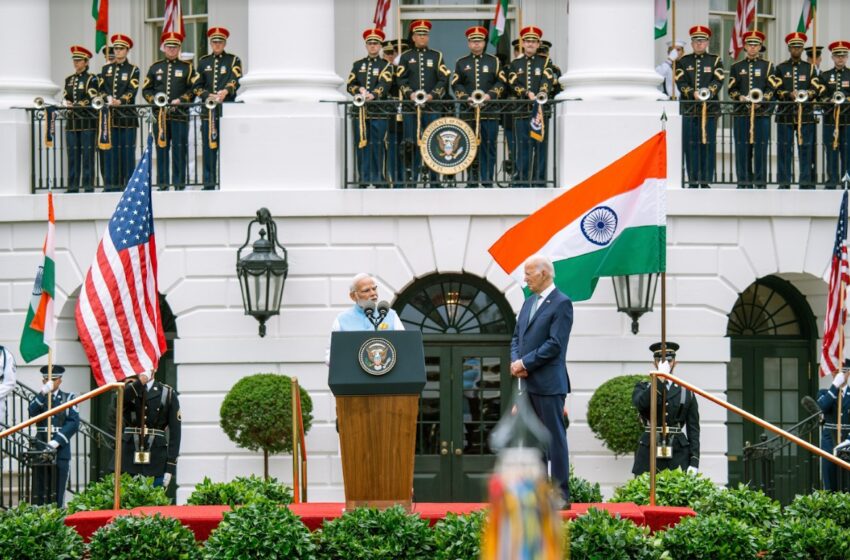A year of milestones in U.S.-India relations

2023 proved to be a pivotal year in India-U.S. relations, marked by two high-profile visits, several key agreements, and a renewed sense of cooperation, highlighting the growing significance of the India-U.S. bilateral partnership on the global stage.
The year began on a high note with the January launch of the U.S.-India initiative on Critical and Emerging Technology (iCET), which aims to enhance and broaden the strategic technology partnership and defense industrial cooperation among the governments, businesses, and academic institutions of both nations.
The pinnacle of the year, however, was undoubtedly the momentous state visit of Prime Minister Modi to Washington in June. During his visit, Modi participated in a state dinner hosted by President Joe Biden and First Lady Jill Biden with over 400 guests – which I was privileged to attend. Modi also delivered his second address to a joint session of the U.S. Congress, a rare honor reserved for very few world leaders.
Read more columns by Frank F. Islam
In addition, during the prime minister’s stay in Washington, several key agreements were signed. They included: a deal between General Electric and Hindustan Aeronautics Ltd. to collaborate on the production of F-414 jet engines in India for the next generation of Tejas fighter jets; a pact for India to procure General Atomics’ armed MQ-9B SeaGuardian UAVs, with assembly operations set up in India; and an announcement of Micron Technology, Inc.’s commitment to invest $825 million in establishing a new semiconductor assembly and test facility in India.
The Prime Ministerial visit went beyond symbolism. It was a testament to the deepening bonds between the world’s oldest and largest democracies. The Modi-Biden meeting convened during the visit covered a wide range of issues, from trade and technology to defense and climate change, with both leaders affirming their commitment to strengthening the bilateral relationship.
In September, President Biden visited New Delhi to attend the G20 summit, hosted by India. Both India and the United States played a central role in shaping the G20’s common agenda, emphasizing shared values and interests between the two democracies. The successful G20 summit underscored India’s increasing influence in global affairs.
The two nations conducted several bilateral military exercises in the past year. Notably, they included “Vajra Prahar” in northeast India in November, “Yudh Abhyas” in Alaska in October, and “Cope India” in northern India in April. These exercises primarily concentrated on enhancing maritime security and interoperability.
Trade is another area that saw a positive trend last year. At the end of the 14th ministerial-level meeting of the India-United States Trade Policy Forum in New Delhi on January 12, 2024, co-chairs India’s Minister of Commerce and Industry Piyush Goyal and U.S. Trade Representative Katherine Tai noted that bilateral trade in goods and services continued to grow throughout the previous year projecting that the trade volume likely exceeded $200 billion “despite a challenging global trade environment.” (The trade figures for December have not yet been announced.)
One point of contention between the two nations last year centered around a U.S. allegation that an Indian government agent had a role in a thwarted plot to assassinate a Sikh militant leader in New York. Both governments managed the situation maturely, preventing it from escalating out of control. By contrast, a similar accusation in September made by Canadian Prime Minister Justin Trudeau damaged relations between Ottawa and New Delhi.
After a year of remarkable achievements, what lies ahead for these two nations in 2024?
The foundation laid in 2023 and the previous years will surely continue to foster a strong and enduring partnership this year. Nevertheless, the bilateral calendar this year is less likely to be as crowded as last year, as both India and the United States are gearing up for a demanding political landscape in 2024 due to the impending elections in both nations.
Typically, national elections tend to redirect attention inward as opposed to outward developments internationally. A telling instance of how domestic politics might take precedence over bilateral relations emerged when President Biden had to decline New Delhi’s invitation to be the chief guest for India’s Republic Day celebrations on January 26 due to a “tight political calendar.” If the president had been able to visit Delhi, India had plans to convene a Quad summit during his stay there.
One notable absence on the personnel front going forward will be Taranjit Singh Sandhu, who has been navigating bilateral relations on India’s behalf as the country’s ambassador to the United States for the past four years. The 1988 batch Indian Foreign Service officer is scheduled to retire later this month. Throughout his tenure as ambassador, as well as in various roles during his three previous stints in Washington, Sandhu has played a vital role in advancing the India-U.S. ties. I am confident that Sandhu’s successor, whoever he or she may be, will do a competent job in furthering the relationship.
In summary, 2023 further cemented the emerging U.S.-India bilateral partnership marked by strong diplomacy, pioneering agreements, and a shared vision for the future. The bonds solidified last year will undoubtedly provide a firm foundation for ongoing cooperation and collaboration. This bilateral foundation will be increasingly important in the years ahead as a platform for promoting stability on a world stage that has become more unstable over the past several years.
